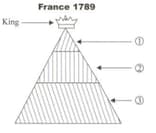It was the duty of the state to protect each citizen’s natural rights.
Important Questions on The French Revolution
Read the statements and select the correct answer form the options given below:
Statement – I: On th May, , Louis XVI called together an assembly of the Estate General to pass proposals for new taxes.
Statement – II: The members of the third estate demanded that voting now be conducted by the principle that each estate had one vote.
Arrange the following events of French Revolution in a chronological sequence
I) Louis XVI is guillotined
II) The Oath of the Tennis court
Ill) The Bastille fall
IV) The French Republic is declared
V) The Great Fear
Match Column A with Column Band choose the correct option-
| Column A | Column B |
| (I) Rousseau | (a) Two Treatises of Government |
| (II) Montesquieu | (b) Marseillaise |
| (III) Locke | (c) The Social Contract |
| (IV) Roget de L'isle | (d) The Spirit of the Laws |
Given below make an Assertion (A) which is followed by a Reason (R). After carefully reading both the Assertion (A) and Reason (R) identify which among the options (1-4) given below is applicable to the question.
1. Both A and R are true and R is the correct explanation of A.
2. Both A and R are true and R is not the correct explanation of A.
3. A is true and R is false.
4. A is false but R is true.
After reading the Assertion and Reason given, choose the correct option.
Assertion (A): The fortress-prison Bastille was loved and admired by everyone.
Reason (R): It symbolised the despotic power of the king.
Which of the following is true about the diagram given?

(a) This was a social class system under the Old Regime
(b) A person's birth decided the level they would belong to
(c) A person could not move from one social class to another
(d) All the above

